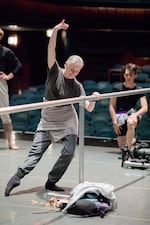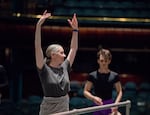
New Artistic Director Dani Rowe teaching Oregon Ballet Theatre dancers.
Blaine Truitt Covert / Oregon Ballet Theatre
The first woman to serve permanently as artistic director at Oregon Ballet Theatre has spent her initial three months gathering input and information to chart the future of the 34-year-old company.
“I don’t like to make knee-jerk decisions. As my grandmother always used to say, ‘Just have a cup of tea before you make any big decisions.’ So I do like to process before launching into the things,” says Dani Rowe, who wants to execute plans “in a way that is sustainable rather than continuous Band-Aid solutions.”
Goals for 2030
Rowe has big dreams for OBT.
She is aiming to eliminate OBT’s apprentices by 2030. For decades, ballet companies have paid apprentices little or nothing, while giving them the opportunity to move up the ranks. Last year, Atlanta joined a handful of dance companies to drop apprenticeships. Atlanta apprentices made less than $500 a week. They now receive $700 base pay as entry-level dancers, according to Pointe Magazine.

Oregon Ballet Theatre's new artistic director, Dani Rowe.
Alexander Reneff-Olson / Oregon Ballet Theatre
“Apprentices, really nine times out of 10, especially in a smaller company, are doing the same work as the majority of the company. But ballet companies use that title [of apprentice] so we don’t need to pay them as much. And to me, that doesn’t sit right,” she says.
OBT has declined to provide salary details.
Rowe also envisions growing the company.
“I would love to have 40 dancers eventually,” she says.
OBT currently has 23 dancers and four apprentices. The company’s roster swelled under Christopher Stowell’s leadership to 28 dancers and nine apprentices in 2009, according to the OBT historian Linda Besant.
“What’s more important to me is that they’re paid well,” Rowe says. “Quite a few of them have to have second jobs. So they rehearse six hours a day and then go and work in the evenings. I would love to provide for my dancers so that they can go home and look after their bodies and rest and recuperate. And what’s really important to me is that they have long, healthy careers.”
Rowe is focused right now on extending their contracts from 34 weeks to 44 weeks.
“It’s going to take money,” says author Martha Ullman West about Rowe’s plans. A dance journalist in Portland since 1979, West has written for publications like The New York Times and Dance Magazine.
“I’m skeptical,” West says. “Historically, it’s been extremely difficult to establish a resident ballet company in Portland. OBT has been, at times in its 35 years of existence, hanging by a thread. This is partly because we don’t have a history of community support the way they have in San Francisco, in New York, and I dare say Kansas City.”
Creative vision
Rowe aspires to mine her rich connections to bring in teachers and choreographers from around the world.
She wants to build on OBT’s strength in presenting both classical and contemporary works.
Full-length ballets are crowd-pleasers. But Rowe hopes to commission or choreograph new full-length pieces that diverge from the usual offerings.
“The definition of ballet is changing. It’s a narrative that is more relevant today. And the movement quality is more contemporary. It’s not the structured classical technique that it was when you see Swan Lake or even Nutcracker,” she says.
This contemporary trend creates a tension with ballet lovers, who want the artform to hew close to its classical roots.
“My principal concern about future programming [at OBT] is the lack of work by George Balanchine,” says West. “There is a trend of thinking that Balanchine is old hat. At the same time, companies are dancing old-hat ballets like Swan Lake and Giselle. I don’t buy it.”
Quite a few of them have to have second jobs...I would love to provide for my dancers so that they can go home and look after their bodies and rest and recuperate. And what’s really important to me is that they have long, healthy careers. - Dani Rowe
Who is Dani Rowe?
Rowe, age 40, has impressive credentials, dancing more than 14 years with Australian Ballet, Houston Ballet and the acclaimed Nederland Dans Theatre.
While her background is steeped in ballet, she pivoted to a more contemporary style during her three-year stint at NDT.
After NDT, she pivoted again — this time to choreography.
“I came upon choreography accidentally,” says Rowe.
In 2015, she retired from NDT to start a family with her husband, Luke Ingham, who is a principal dancer at San Francisco Ballet.
After having their first daughter, Rowe was encouraged to choreograph a piece for SFDanceworks, where she later became an associate artistic director.
Her foray into choreography was a juggling act that started when her husband came home from dance rehearsal. “I would breastfeed and put the baby down and I’d have a two-hour window. Fortunately, the studio was down the street. So I’d run down and start choreographing,” she says. “At first it was really stressful, just managing it all. But it became my therapy. I could be creative.”
Rowe says breastfeeding inspired her dance-making.
“Breastfeeding is the most beautiful thing and something that I actually really miss. But I would take that time to imagine what I would do in the studio,” Rowe says.

Oregon Ballet Theatre performed "Dreamland" last year. It was choreographed by Dani Rowe.
Blaine Truitt Covert / Oregon Ballet Theatre
Her choreographic talent caught the eye of artistic directors, and commissions started to trickle in. Rowe has created works for companies like San Francisco Ballet, Nederland Dans’ SWITCH Program and Royal New Zealand Ballet.
Rowe plans to continue choreographing for other dance companies twice a year, while helming OBT.
“I’m cheering for her. For one thing, she’s protecting her own career doing that. That also means that other choreographers will be making work on OBT. So the company isn’t a vehicle for a single choreographer,” says West.
A first at OBT
West says the atmosphere at OBT has changed since Rowe took over.
“The dancers look great and they look happy. And I commend Dani for that,” says West.
Rowe is the first woman to take the official role of artistic director of OBT. Anne Mueller stepped in as an interim director in 2013, after Stowell resigned. Kevin Irving led the company from 2014-20, followed by Peter Franc as an interim director.
A report by Dance Data Project found that 71% of ballet company artistic directors around the world are men. The disparity is astounding, considering ballet classes and stages are predominantly filled with ballerinas. Rowe believes men dominate the top jobs because the few boys or men who pursue ballet are prized and sought after.
“A boy enters into the classroom and, ‘Oh my goodness, thank you for being here. We’re so happy you’re here. We’ll do anything to keep you here.’ I think with that mindset, you kind of get trained from a young age to somewhat worship a male figure in a ballet studio. That’s my theory,” says Rowe.
“We’ve been somewhat programmed to not even think that we should be at the front of the room and that our opinions and voice and thoughts are worthy. But that’s changed and we are 100% worthy of sharing our opinions and thoughts if not more, because we’ve been the ones doing the work.”
Rowe applied for OBT’s lead position after friends kept sending her the job posting.
Portland had already been on her radar.
She and her husband fell in love with the Oregon Coast while vanning around the state in 2016.
“We turned to each other one night and we’re like, this is where we’re going to end up. This is where we’ll live one day,” she says.
Last year, she got a close-up look at OBT and Portland when she was hired to set her choreography of Dreamland on company dancers.
Rowe will live in Portland, and her husband and their two daughters, ages 3 and 7, will stay in San Francisco for now. The family will commute back and forth until they figure out the rest of the story.
“My grand vision is for the Portland community and hopefully Oregon, because we are Oregon Ballet and not just Portland, that when people hear OBT, they know who we are and they can come and see any show and they just know what we’re about and that they’re going be presented with a quality performance.”





